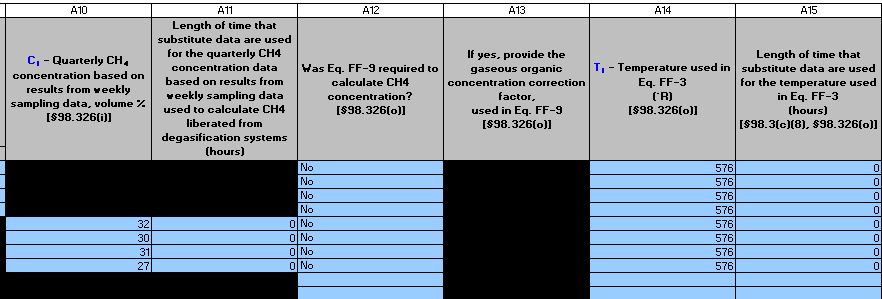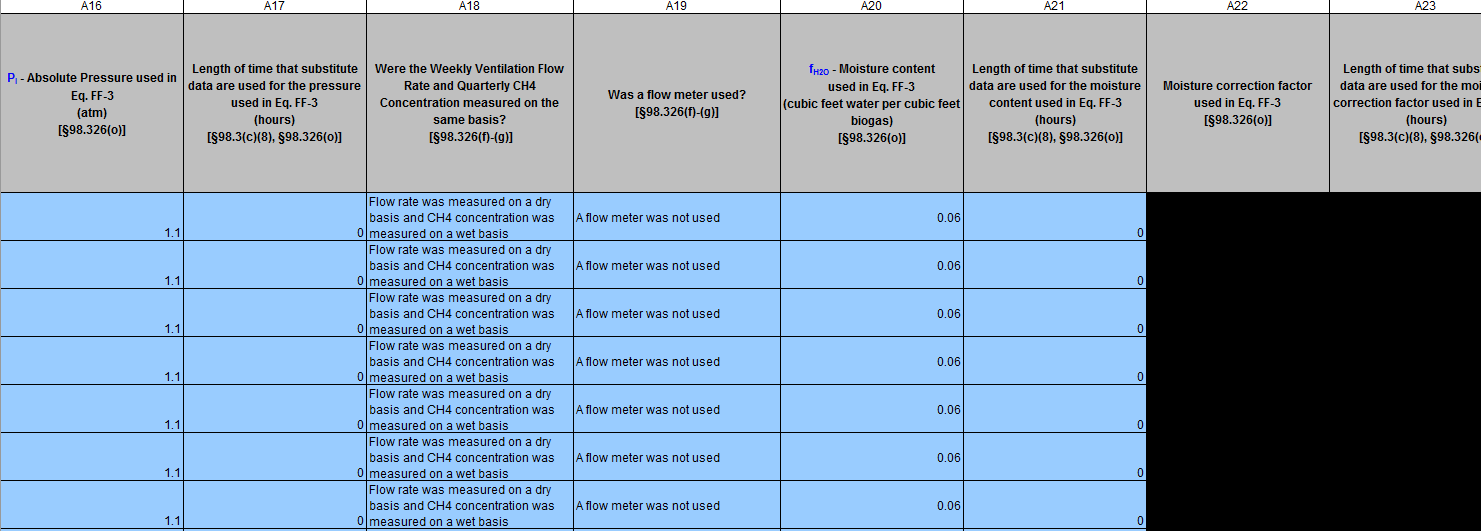Degas Quarterly
Please see Reporting Form Instructions on downloading the blank reporting form and uploading the completed reporting form.
Table 5 Instructions: Fill out the following table for Degasification Gas Collection System Monitoring Points on a quarterly basis. Complete the table from top to bottom without skipping rows. Complete four rows (quarters) for each monitoring point. The table below includes space for 160 rows. If more are needed, please submit a request to the e-GGRT Help Desk at GHGReporting@epa.gov.
The pick list in the first column links to a previous sheet, to restrict entry to previously entered well or monitoring points.
For perspective the entire table width, 21 columns, is presented below. Enlarged views of this table presented below the perspective view.
Click this link to expand
The following example shows the first 9 columns:
- Degasification Gas Collection System Monitoring Point - Corresponds to centralized monitoring point or individual well from previous tab (Tab 3) Select from the pick list
- Quarter Select from the pick list
- Dates where degasification of mining operations is taking place (start date and stop date).
- If there was continuous degasification during the quarter, insert the first date of the quarter in the column labeled "Start date" and insert the last date of the quarter in the column labeled "Stop date". If there were interruptions, include as many rows as needed for the well monitoring point/ quarter combination.
- Dates where degasification of mining operations is taking place (start date and stop date).
- Method used for concentration Select from the pick list
- If Method 1 (CEMS) is selected, you are required to provide the following information:
- The quarterly CEMS CH4 concentration used to calculate CH4 liberated from degasification systems
- The length of time that substitute data are used for the quarterly CEMS CH4 concentration used to calculate CH4 liberated from degasification systems
- The dates when continuous monitoring equipment is not properly functioning, if applicable (start date and stop date). Insert the first date of the episode in the column labeled "Start date" and insert the last date of the episode in the column labeled "Stop date"; include as many rows as needed for the quarter. If CEMS was not used during the quarter, or if CEMS was functioning properly during the quarter, do not enter any information in these columns.
- If Method 1 (CEMS) is selected, you are required to provide the following information:
Click this link to expand
The next example shows the next 6 columns:
- If Method 2 (weekly sampling) is selected provide the quarterly CH4 concentration based on results from weekly sampling data
- If Method 2 (weekly sampling) is selected provide the length of time that substitute data are used for the quarterly CH4 concentration data based on results from weekly sampling data used to calculate CH4 liberated from degasification systems
- Was Eq. FF-9 required to calculate CH4 concentration? Select from the pick list
- If yes, provide the gaseous organic concentration correction factor, used in Eq. FF-9
- Temperature used in Eq. FF-3
- Length of time that substitute data are used for the temperature used in Eq. FF-3
Click this link to expand
The final example shows the last 8 columns:
- Absolute Pressure used in Eq. FF-3
- Length of time that substitute data are used for a pressure used in Eq. FF-3
- Were the Weekly Ventilation Flow Rate and Quarterly CH4 Concentration measured on the same basis?
- Was a flow meter used?
- Moisture content used in Eq. FF-3 (cubic feet water per cubic feet biogas)
- Length of time that substitute data are used for the moisture content used in Eq. FF-3
- Length of time that substitute data are used for the moisture correction factor used in Eq. FF-3 (note: this data is applicable to RY2013 and later reporting years. This column is disabled for RY 2011 & 2012)
- Moisture correction factor used in Eq. FF-3 (note: this data is applicable to RY2013 and later reporting years. This column is disabled for RY 2011 & 2012)
Click this link to expand





